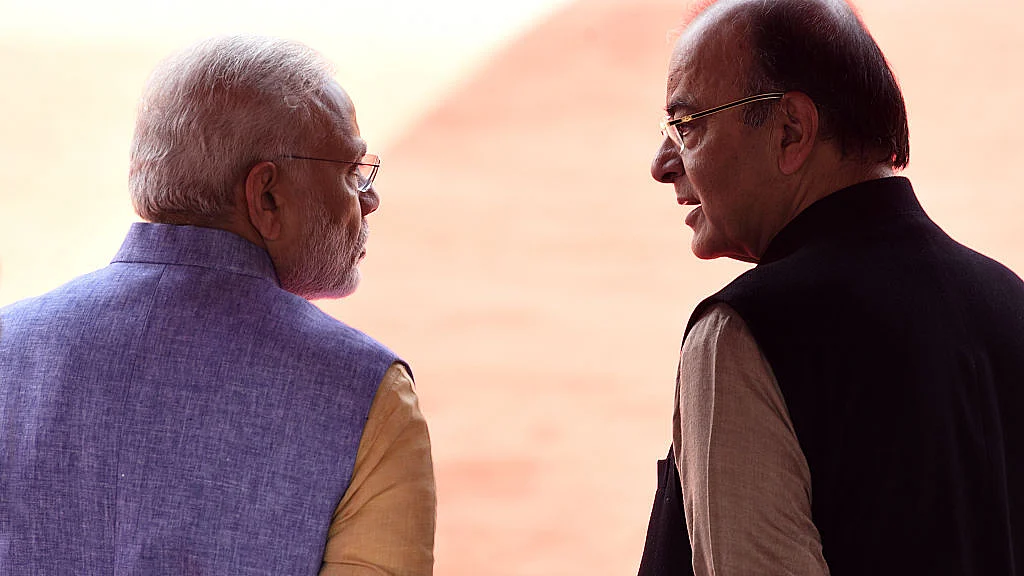Does Jaitley have a magic wand?
The ‘official’ GDP growth rate tries but fails to reflect Acche Din

The Central Statistical Organisation (CSO) recently released the advance estimates of national income for 2017-18. As the year concerned is not yet over, these estimates are not just based on lesser data than that which would form the basis for the final estimates but are projections for the full year based on available data for part of it.
Indeed, if one looks at the full-year overall GDP and GVA (output measure) growth rates in the Advanced Estimates; they are very close to the figures for the second quarter of 2017-18, which were released a little over a month earlier. Thus, aggregate GVA growth in Q2 of 2017-18 over the same period the previous year was supposed to be 6.3 per cent while the full 2017-18 growth in the Advance Estimates is 6.5 per cent. Similarly, aggregate GVA growth has been estimated at 6.1 per cent for either period.
The Advanced Estimates indicate that the growth performance of the Indian economy in 2017-18 will be a little poorer compared to the previous year, but would be better in the second half of 2017-18 than in the first. In other words, it suggests that demonetisation and the introduction of GST did have a dampening effect on the economy but this is wearing off. If this continues then one can expect a 7 per cent plus growth rate in the next year, which would be very good compared to the situation in most other parts of the world. At least that’s what the CSO’s estimates are indicating to us! Is that, however, a true reflection of the health of the Indian economy?
Whether advance, provisional or final – the GDP figures we are now talking about are from the new GDP series with 2011-12 as base year which was launched in 2015. The new series involved important changes in the method used to arrive at the estimates, one of whose observed consequences was a raising of the GDP growth rate compared to what were derived from the pre-existing GDP series – at least for the initial years of the decade for which both sets of estimates were available.
The new GDP series has consequently been controversial and there are many who, based on reason and not empty belief, think that the actual growth rate of the Indian economy in the current decade has been significantly lower, maybe by about two percentage points, than what the GDP data show. To the extent that GDP growth rate is an indicator of the health of an economy, the Indian situation may be currently poorer than what first impressions indicate.
The story becomes grimmer once one goes beyond the overall GDP growth and looks at what is happening in different sectors of the economy. On an average, agricultural growth has been poor through the decade and this is corroborated by production data. The signs of distress today in the sector on which is still dependent the largest share of the Indian work-force are also there in farmers’ protests and suicides which have been so much in the news.
India’s industrial sector is virtually stagnating and even the new revised Index of Industrial Production (IIP) with 2011-12 as base year shows this up – and the mismatch between what the IIP shows and what the GDP data shows thus continues. A country that has never fully industrialised, instead of congratulating itself should certainly be concerned about the trends in Indian industry. The sharp slowdown in the construction sector, the sector which was by far the most important activity for expansion in employment since the 1990s, should also be considered a sign that all is not well in the Indian economy.
Similar is the case with investment - while supposedly everything is being done to improve the business climate, the stagnation in investment continues and the investment ratio (investment-expenditure to total GDP) has been continuously falling. On the external trade front too, the long-term trends are poor. Data on industrial and rural wages also show clear signs of stagnation in them – certainly not growing at a rate which would correspond to the official GDP growth rate.
So, the CSO’s GDP data hides more than it reveals about the state of the Indian economy if we only focus on the growth rate figures that it throws up. The same data, however, does show a somewhat different picture if one goes beyond the overall growth figures.
If these are then combined with a few other indicators (many of which like the IIP are also released by the CSO) – then there is sufficient evidence that the GDP growth rate does not reflect the true state of the health of India’s economy. Agrarian distress, a widespread employment and incomes crisis and industrial stagnation are realities of the economy that need to be addressed urgently. Even those with the means to invest, like the corporate sector, do not seem to be having great faith in the future prospects of the economy and are therefore not investing heavily.
Excessive focus on the GDP growth rate may temporarily put a veil on these problems, but that hardly serves the objective of fixing them!
Follow us on: Facebook, Twitter, Google News, Instagram
Join our official telegram channel (@nationalherald) and stay updated with the latest headlines
